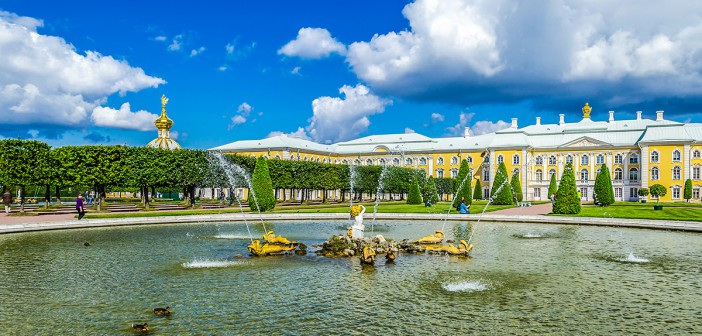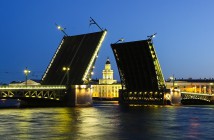All our excursions to the Peterhof include visiting of the Upper Gardens.
The Upper Gardens of Peterhof
The Upper Gardens, covering about 15 hectares (40 acres), were designed as a kind of formal approach to the Great Palace. The Gardens are as wide as the span of the Palace’s southern façade, and reflect its main divisions in the scheme of their layout.
On three sides the Gardens are enclosed by a railing of wooden spears arranged in units which are separated by plastered brick pillars with lion masks. A gate of hammered iron, hung between two monumental piers ten metres high, adorned with paired columns with Corinthian capitals, elaborate cornices, and sumptuous finials which once carried gilded sculptures, serves as the main entrance to the Gardens. The design of its ironwork is distinguished by austere simplicity.
Square, Radial, and Circular
From the gate opens the vista of the Gardens, leading up to the Palace. Most of their layout is occupied by a parterre and six square enclosures, three on either side, each pair with a distinctive pattern, from which their names are derived: Square, Radial, and Circular. The formal character of the parterre is further enhanced by a belt of trimmed trees and shrubs set along the perimeter, and the geometrical pattern of the fountains (two Fountains of the Square Pools and the Oak, Neptune, and Mezheumny (Midway) Fountains) as well as such features as marble statues, trellised arbours, and covered walks.

The Upper Gardens were laid out in their original form to the designs of Braunstein and Le Blond, by the master-gardeners Harnigfelt and Borisov, between 1714 and 1724. Known as the kitchen-garden, they grew vegetables, dill, parsley and other herbs, and various medicinal plants. The fountain bowls erected at the suggestion of Jean-Baptiste Alexandre Le Blond were not just reservoirs for the fountain system, but were also used as fish ponds. Thus, the Upper Gardens performed domestic tasks, first and foremost.
By the second quarter of the 18th century, however, the vegetables and fish ponds had been replaced by avenues of finely clipped trees, trellis summer-houses and richly ornamented fountains that gave the small area the appearance of a formal garden.
Between 1733 and 1739 fountains, richly decorated with gilded lead sculptures, were set up in the three pools already in existence and in two newly-made ones. During the same period, the parterre was adorned with statues, trellised arbours and galleries were created, and the enclosures took on their final shape. In the 1730s, the architects Blank and Davydov and the sculptor Bartolomeo Carlo Rastrelli continued the decoration of the Upper Gardens. The last major alteration in the layout and decor of the Gardens took place between 1754 and 1760, when Bartolomeo Francesco Rastrelli, the architect, widened them to match the altered façade of the Great Palace, and built a monumental railing broken by the main gate.
The plan of the Gardens and their fountain and sculptural decor underwent few changes in the course of their history, but the statues were gradually replaced, as the leaden figures lost their shape with time. In the 1770s, the general decor and the jet patterns of the Fountains of the Square Pools, the Midway and the Oak Fountains were partly altered.
In 1799 the deformed leaden sculptures of the Neptune Fountain were replaced by a bronze group, also representing the Chariot of Neptune, bought from the town of Nuremberg.

In the nineteenth century, the Upper Gardens lost their style
In the nineteenth century, the Upper Gardens lost much of their formal style. Restoration work in 1929, under the direction of Nikolay Arkhipov, attempted to reproduce the Gardens’ original character, but they were almost completely ruined by the Nazi occupation of 1941-44.
It was only in 1972 that the Upper Gardens regained their original aspect, the restoration being effected to plans of Piotr Kovalevsky, Regina Kontskaya, and Xenia Agapova.
Почему вам стоит обратиться к нам- Уровень сервиса
- Интересная культурная программа
- Оперативность предоставления услуг
- Скорость ответа
- Квалификация гидов
- Нет очередям!
- Доверие
Получите бесплатную консультацию по телефону в Санкт-Петербурге:
+7 (812) 309-28-66
или напишите нам


